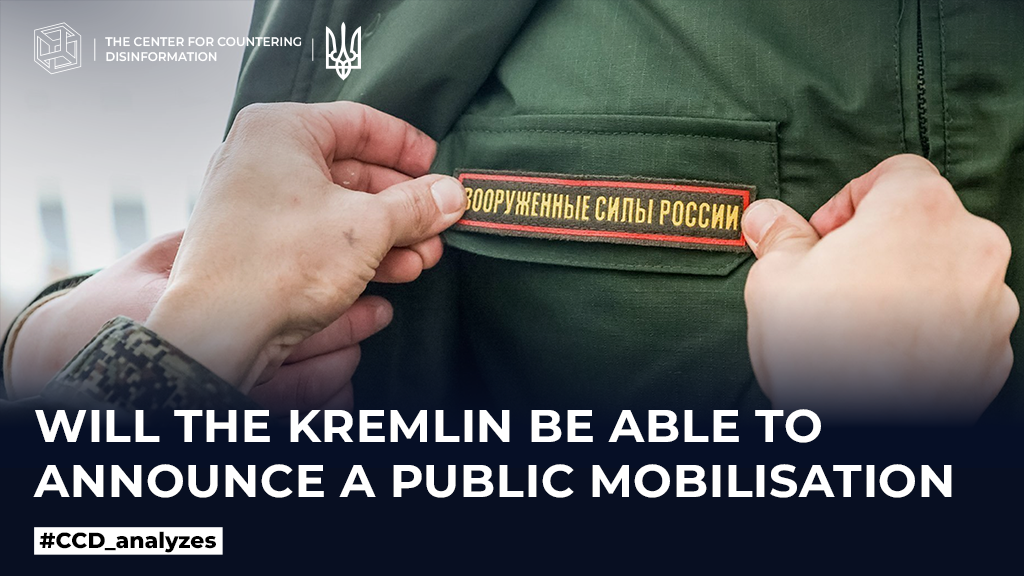It is no secret that the main source of some of russia’s military successes in Ukraine was the mercenaries of the “wagner” PMC. The russian generals did not care that the “meat assaults” on Popasna, Soledar and Bakhmut cost “wagner” more than 20,000 lives of ex-convicts. However, after the “march” of prigozhin, such a resource no longer exists, the activity of the few mercenaries who joined the “storm Z” units of the russian army has dropped significantly and cannot be considered a threat to the Armed Forces of Ukraine. Therefore, the problem of announcing a new wave of mobilisation in autumn is back on the kremlin’s agenda, otherwise the russian armed forces will physically lack the manpower to deter a Ukrainian counteroffensive.
Panic gossip about the upcoming mobilisation (even the date is mentioned – allegedly September, 25) has brought this issue to the brink of social revolt on russian social media. Intimidated by the level of civil disobedience, all branches of government are forced to assure that a new wave of mobilisation is not expected, and that “the planned recruitment for contract service is underway”. In order to somehow remedy the situation with replenishing military losses, the kremlin continues covert mobilisation activities and is now looking for ways to increase the motivation of russians to voluntarily “go to the slaughter”. Therefore, the state duma has already passed a number of laws and regulations that toughen penalties for failure to appear at the military registration and enlistment office and for evading mobilisation. On 20 June, the state duma passed a bill allowing citizens serving sentences for minor crimes to sign contracts for military service. Furthermore, putin’s decree raised the age limit for conscription from 27 to 30, and the draft notice is now sent electronically. Voluntary mobilisation has become the main criterion for obtaining a russian passport for residents of post-Soviet countries bordering russia. By the way, putin’s decree on preliminary mobilisation of 21 September 2022 is still in force, and nothing prevents mobilisation under this document. It is expected that after the local elections on 10 September this year, the occupation authorities will begin mass mobilisation of the population in the occupied territories, where a census has already been conducted and relevant campaigning is underway. After all, a significant proportion of the population of “continental” russia is extremely outraged that instead of residents of the “new” regions of the russian federation, they are “liberating Ukraine from Nazism”. Of course, first of all, those who have received russian passports will be sent to war. To participate in the war against Ukraine, the russian ministry of defence is trying to recruit labour migrants from Central Asia, which has already caused international scandals.
What is holding the kremlin back from announcing a new mass mobilisation now?
russia is delaying the announcement of a general mobilisation because of fears that it could become a trigger for a social revolution in russia. Mobilisation activity is also limited by russia’s economic problems. For example, Forbes estimates that the new mobilisation will cost the russian budget $7.5 billion and an additional $3 billion per month to maintain them, which could become a critical burden for the russian budget. However, the kremlin will certainly take advantage of the large-scale mobilisation when events on the frontline directly threaten the existence of putin’s regime.
How does this affect the war in Ukraine?
From a military point of view, russia desperately needs to restore its army resources, but due to the rejection of mobilisation by russian society, the putin regime has so far refrained from announcing a new wave of mobilisation. Until putin decides to do so, the available forces and means of the russian army will be sufficient only for a defensive operation, i.e., to hold the positions occupied and the temporarily occupied territories. According to the russian armed forces general staff, covert mobilisation in russia allows for 20,000 more troops per month, which is not enough to compensate for the losses of russians on the Ukrainian front.
After all, against the backdrop of real losses (over 400,000 killed and wounded), only replenishment of the reserve army, which is to operate on the territory of russia, requires approximately 150,000 mobilised people, and compensation for combat losses requires an additional 15-20,000 soldiers every month. It should be taken into account that instead of the killed career soldiers, the russian army is increasingly being replenished with contract soldiers with no combat experience and no motivation. This creates favourable conditions for the development of Ukrainian counter-offensive.
❗️Despite that the kremlin is trying to delay a new wave of open mobilisation as much as possible, fearing internal destabilisation, it is quite possible that it will happen soon. So, while the kremlin is hesitant to announce a major mobilisation wave, the main task of the Armed Forces of Ukraine is to use the entire arsenal of forces and means to remotely increase the level of enemy losses, which will allow us to seize the strategic initiative and achieve a significant advantage on the battlefield. This is why a significant increase in military assistance from our partners, primarily aircraft, artillery systems and long-range ammunition, is so important.










